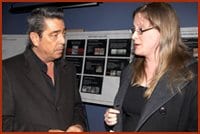We’re here, and we’re queer, but the Bank St BIA doesn’t seem to notice.
Frustration levels rose amongst the gay community in the spring, when the city unveiled their plans for the reconstruction of a portion of Bank St, but left the gay community out.
Now, the Bank St Business Improvement Area board has revealed that, after a vote, they are deciding to pass on the idea of an official gay village.
“The board feels that the branding of a specific geographic area will naturally occur following the adoption of a specific theme by a growing number of individual businesses,” wrote the BIA in a Jul 24 press release.
“As such, the board believes that no action is required on its part at this time.”
Gerry LePage, executive director of the Bank St BIA, was unreachable for comment on the decision.
City councillor Diane Holmes, a longtime supporter of the gay community, says she is disappointed with the BIA’s decision to brush aside the countless requests for an official gay village.
“There was a vote at the Bank St BIA meeting about the bottom-up branding policy and I voted against it — everyone else voted in favour of it,” says Holmes.
In their press release, the BIA board states that they support “the universally accepted practice of branding a specific area from the bottom-up.”
According to the BIA, “bottom-up branding entails a process whereas a specific culture or subculture, coalesces, congregates and/or consolidates their businesses, residences, social and entertainment venues in a specific well defined geographic area.
“The massing of the subculture in a specific area must be in sufficient numbers so to be the predominate factor in both the physical and cultural landscape of designated or targeted area.”
During the month of May 2008, the Bank St BIA retained research advisors to conduct two rounds of surveys with business owners within the proposed gay village, which produced highly skewed results in the end.
The first survey concluded that 75 percent of businesses were not in favour of an official village, while the second survey found 73 percent of businesses were, in fact, in favour of branding the section of Bank St from Nepean to James as the Village.
The BIA’s press release is silent about which businesses were polled, how far apart the two separate surveys were conducted, and what may have changed to produce such drastically different results.
Jeremy Dias, executive director of youth diversity initiative Jer’s Vision, has been working on the Village initiative, and has been doing outreach to a variety of different businesses on Bank St.
He says the survey results were so negative the first time around because of a lack of awareness amongst businesses owners in regards to the Village initiative.
“While we were hitting the streets doing outreach, a number of business owners that we talked to didn’t even know that it fell under the BIA’s mandate to brand the street,” says Dias.
Holmes says that she believes some business owners’ concerns may derive from the fear that the area will become exclusive to the gay community, despite the fact that advocates of the project have repeatedly stated that the Village will be very much inclusive.
“I think what needs to happen is more of the GLBT community dropping into stores on Bank St just to let business owners know that they support them, and shop at their stores,” Holmes suggests.
“It’s also time for the GLBT community to ask for a meeting with the board, and get all the gay businesses in the area on board.”
Whether the BIA chooses to recognize it or not, Bank St has come to be known as the place where gays live, work and play.
“The fact is that our community groups and most of our gay-owned businesses are located here, and the neighborhood has the highest density of gays and lesbians of any neighborhood in the city,” says Gareth Kirkby, associate publisher of Capital Xtra.
“The community has been amazing in organizing for this designation. All people have asked for is recognition of a reality that’s already on the streets, and I think that the BIA is being unfair and frankly, pigheaded about this.”
Glenn Crawford, who has been spearheading the Village project is away on vacation and unavailable for comment.
He sent out a lengthy email before leaving town expressing anger and disappointment about the BIA’s decision. The gay community would not give up on their efforts, he wrote.
“This effectively is an attempt to shove us as a community back into the closet within our main neighbourhood,” wrote Crawford.
“I will not accept this decision as final, even if this means that together we are going to have to build a Village for ourselves, at least for now. Rather than being discouraged, I know that we can do it, and I won’t let the community down.
“After all, we have a long history of rising to a challenge.”
Advocates believe that a village will eventually happen, with or without the BIA — even if it takes a little more time and a lot more effort.
Kirkby suggests the community needs to make itself more obvious on the street. Groups could organize major events that require closing the street to automobile traffic, he says. And individuals should drop in on the businesses that sit on the board of the BIA and make their displeasure known.
“These sorts of things take time — it won’t magically become a gay village overnight — we need continued dialogue with businesses and the BIA,” adds Dias.
“If the BIA wants bottom-up branding, let’s give it to them. The only thing I fear or wonder, though, is if it might be prejudice that’s preventing the dialogue.”

 Why you can trust Xtra
Why you can trust Xtra


